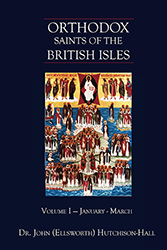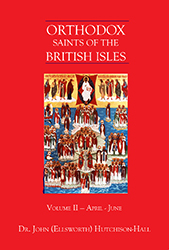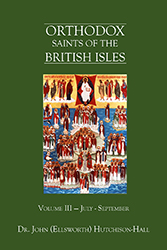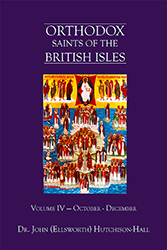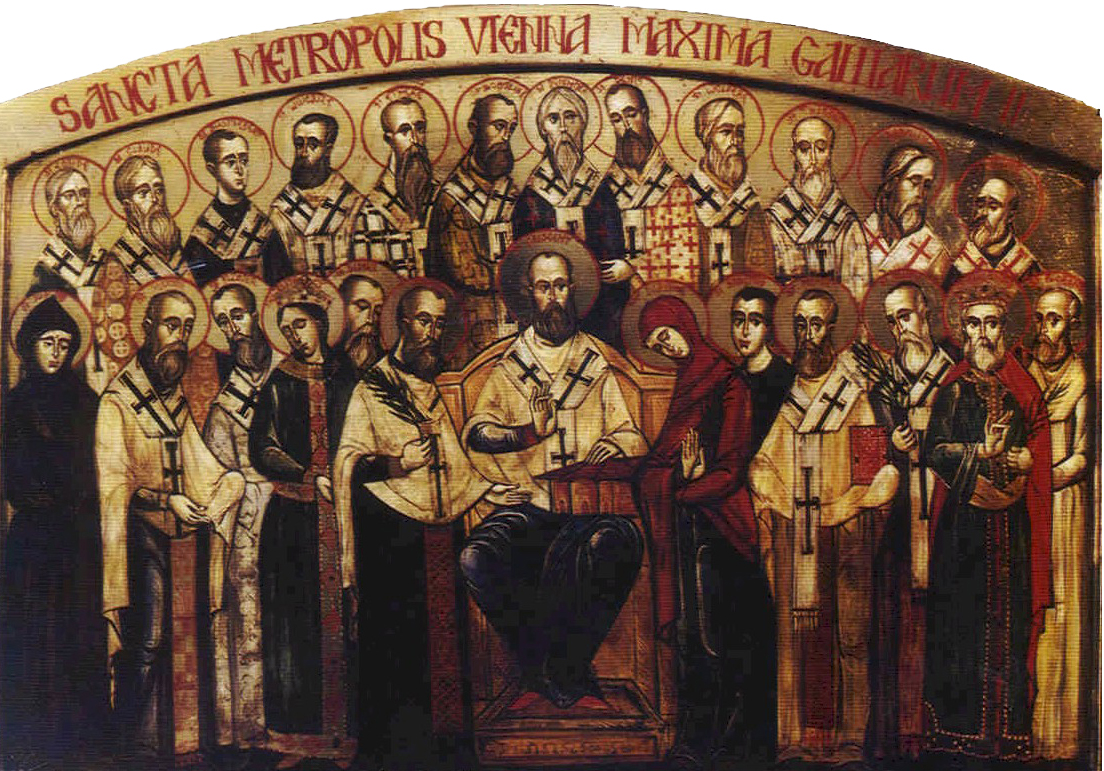
Orthodox Saints of the Pre-Schism
See of Rome
15th November (NS) — 2nd November (OS) 2024
AMBROSE of AGAUNE, two monks both named Ambrose, who served as Abbots of the Abbey of St. Maurice (abbaye de Saint-Maurice d'Agaune) in present-day Saint-Maurice-en-Valais, Switzerland. The first St. Ambrose's repose has been listed as both 516 and 523, and the second in 582.
AMICUS of FONTE AVELLANA, a priest, hermit, and monk at the Venerable Hermitage of the Holy Cross (Monastero di Fonte Avellana) in present-day Serra Sant'Abbondio in the Marche region of central Italy. St. Amicus reposed circa 1045.
BAYA of SCOTLAND and MAURA of SCOTLAND, (Tenth Century), St. Baya was an anchoress on the Isle of Cumbrae in the Firth of Clyde in western Scotland. Her fellow anchoress and disciple, St. Maura lived at Killmaur in Ayrshire. In time, a community of monastics grew around St. Maura and she served as its abbess. It is possible that St. Baya is the same person as St. Bega (6th September).
DOMNINUS of GRENOBLE, (Late Fourth Century), the first historically verifiable Bishop of Grenoble (south-eastern France). St. Domninus was one of the thirty-two bishops in attendance at the Council of Aquileia in 381.
ERC (ERTH, HERYGH, URITH), (in Cornwall 31st October), St. Erc mac Dega (Latin: Ercus; Cornish: Erth) is believed to have been a pagan druid converted by St. Patrick of Ireland (17th March), who later consecrated him first Bishop of Slane, Co. Meath, Ireland. According to tradition, St. Erc founded the original Abbey on the Hill of Slane as well as the school at Slane Abbey, where St. Dagobert II, King of Austrasia (France) (r. 675–679) (23rd December) is believed to have received part of his early education. St. Erc was also a friend and tutor of St. Brendan the Voyager (16th May).
Around 450 St. Erc was chosen by St. Patrick to continue St. Benignus of Armagh's (9th November) evangelisation of Co. Kerry, when the later was sent to Northern Co. Clare and the present-day Province of Connaught. Initially St. Erc's jurisdiction appears to have included a large part of south-west Co. Limerick, including the monastery of St. Ita of Killeedy (15th January) at Killeedy. Shortly before his repose, St. Patrick expanded the area over which St. Erc was responsible to include Co. Cork, thereby placing most, if not all, of the area that comprises present-day Province of Munster under St. Erc’s supervision.
St. Erth of Cornwall is generally believed to be the same man as St. Erc. Brother of SS. Unni of Bremen (17th September) and Ia of Cornwall (3rd February), he is thought to have crossed from Ireland to Cornwall, where a church and the village of St. Erth are dedicated to him. This is based upon local tradition, supported only by fifteenth-century English chronicler and antiquary, William of Worcester (†c. 1482): “Saint Herygh, the brother of Saint Uny, a bishop, lies in a certain church situated under the cross of the church of St. Paul in London; his day is kept on the vigil of All Saints, that is, the last day of October ... Saint Hya ... the sister of Saint Herygh ...” Herygh is an incorrect corruption of St. Erc’s name, and the reference to St. Paul’s is undoubtedly the result of confusing St. Erc with St. Erconwald of London (30th April).
St. Erc spent the last years of his life in prayer and solitude at a hermitage in Slane. According to the Annals of Ulster, St. Erc reposed on 2nd November 512. His feast is kept on 2nd November in Ireland and on the calendar of the Moscow Patriarchate, and on 31st October in Cornwall.
Troparion of St. Erc (Ireland)
Tone I
Even in the darkness of heathendom/
thou didst recognize the God-given authority of Ireland's Enlightener, O Hierarch Erc,/
and wast baptized at his hands./
Wherefore we beseech thee, pray to Christ our God/
that being blessed with the virtue of humility/ we may be found worthy of eternal salvation.
Troparion of St. Erc (Cornwall)
Tone VIII
For four score years and ten thou didst grace the Cornish land/
with thy godly presence, O Father Herygh./
Therefore pray to God for us that we may devote every year of our lives to His service,/
that at the end we may be found worthy of eternal salvation.
GEORGE of VIENNE, a late seventh or early eighth century Bishop of Vienne (south-eastern France).
JUSTUS of TRIESTE, a citizen of Trieste (north-eastern Italy), St. Justus was arrested for being a Christian during the Diocletianic Persecution (303–313). Even when subjected to torture he still refused to renounce Christ and so was weighted down and thrown into the sea where he drowned.
PUBLIUS of NORTH AFRICA, VICTOR of NORTH AFRICA, HERMES of NORTH AFRICA and PAPIAS of NORTH AFRICA, (Date Unknown), martyrs in North Africa of whom the only information extant is their names.
VICTORINUS of PETTAU, a Bishop of Pettau in Styria (Steiermark in present-day Austria). According to the Martyrologium Hieronymianum, St. Victorinus was the first theologian to use Latin for his exegesis. Though it appears he was a prodigious writer, only an extremely limited selection of his work survives to the present. St. Victorinus was martyred during the Diocletianic Persecution (303–313).
ARNULF, the twenty-eighth Bishop of Toul in the north-east of present-day France. St. Arnulf served this See from 847 until his repose in 871. He was one of the ecclesiastics who opposed King Lothair II’s attempts to have his marriage dissolved.
DESIDERIUS, the thirteenth Bishop of Cahors, St. Desiderius succeeded his brother Rusticus to the See in 630 by request of the inhabitants. He served as Bishop until his repose in 655. As Bishop St. Desiderius fostered the growth of monasticism and was responsible for the building of three basilicas in his diocese.
EUGENE, (Date Uncertain), a fellow missionary with St. Denis of Paris (9th October). Whilst preaching the Gospel near Paris, St. Eugene was martyred by pagans. Some, or all, of his relics were translated to Toledo Spain, circa 1148.
FELIX of NOLA, not to be confused with the better-known St. Felix of Nola whose martyrdom in 250 is commemorated on 14th January. This St. Felix was the first Bishop of Nola near Naples, and was martyred, along with thirty companions, in 287.
FINDAN (FINTAN), a native of Leinster who was captured by Vikings and taken to the Orkneys as a slave. St. Findan managed to escape and headed to Rome as a pilgrim. As he was returning, St. Findan stopped at Rheinau Abbey (in the present-day Canton of Zürich, Switzerland), remaining there as a monk and for the last seventeen to twenty-two years of his life as a hermit. St. Findan reposed in either 827 or 879.
LUPERIUS, a Bishop of Verona, of whom no details are known, but is believed to have flourished in either the sixth or eighth century.
MACHUDD (MECHELL), (Seventh Century), the founding abbot of the monastery of Llanfechell (Church of St. Mechell) in Anglesey, Wales. A variety of miracles have been attributed to St. Machudd during his life including raising a giant from the dead, and then converting him to Christianity; turning thieves to stone, and then blinding and curing their leader.
MALO (MACHUTIS, MACLOU), (Late Sixth Century), a one-time disciple of St. Brendan the Voyager (16th May) and Welsh bishop, who evangelised, and was the first bishop of, the area of Brittany centred in what is present-day Saint-Malo.
PADUINUS (PAVIN), a monk at the Abbey of St. Vincent in Le Mans, who later served as the first Abbot of St. Mary's near Le Mans. St. Paduinus reposed circa 703.
SECUNDUS, FIDENTIAN, and VARICUS, (Date Unknown), martyrs in Africa Proconsularis of whom nothing further is known.
Prior to the Schism the Patriarchate of Rome was Orthodox, and fully in communion with the Orthodox Church. As Saint John of Shanghai and San Francisco +1966 said “The West was Orthodox for a thousand years, and her venerable Liturgy is far older than any of her heresies”.
Details of British Saints excerpted from Orthodox Saints of the British Isles.
Details of continental saints from these sources.
In many cases there are several spelling versions of the names of saints from the British Isles. I use the Oxford Dictionary of National Biography version as the primary version with the more prevalent version in parenthesis e.g. Ceadda (Chad) of Lichfield.
